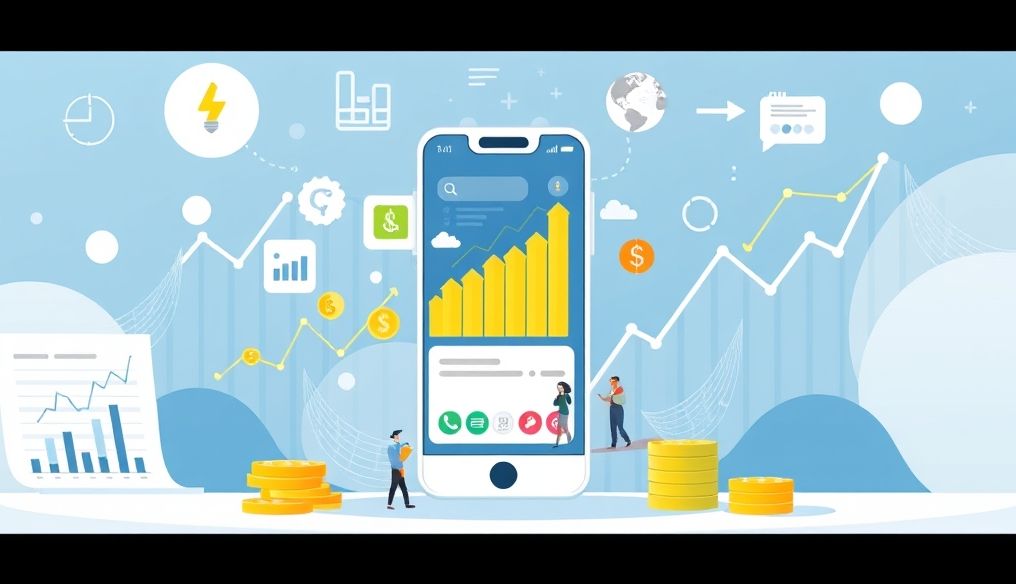Introduction: The World of Mobile Apps and Available Opportunities
The mobile app market is experiencing tremendous growth, making it a golden investment opportunity. With billions of users worldwide relying on apps in their daily lives, the need for innovative applications that meet their diverse needs is increasing. This article will provide you with a comprehensive guide on how to capitalize on this market and profit from mobile app development.
Chapter 1: Identifying a Profitable App Idea
The first step towards success is identifying a unique and in-demand app idea. Here are some tips:
- Look for Problems: Identify the problems users face and try to find solutions for them through your app.
- Analyze the Competition: Study existing apps in the market and try to offer something different or better.
- Use Keyword Research Tools: Such as Google Keyword Planner and Ahrefs to find popular keywords related to apps.
- Surveys: Conduct surveys to find out the needs and desires of users.
Example: An app to organize medical appointments and remind patients of their appointments, with the ability to communicate with doctors through the app.
Chapter 2: Feasibility Study and Market Analysis
Before starting app development, a comprehensive feasibility study should be conducted to determine the potential for profit. The feasibility study includes:
- Target Market Analysis: Identifying the size of the market, the demographic characteristics of the target users, and their needs.
- Competitor Analysis: Identifying the strengths and weaknesses of competitors, and the opportunities available in the market.
- Cost Estimation: Determining the costs of development, marketing, and maintenance.
- Revenue Estimation: Identifying potential revenue sources, such as advertising, subscriptions, and in-app purchases.
Example: An online language learning app targeting young people who want to learn new languages at affordable prices.
Chapter 3: App Design and Development
After completing the feasibility study, the app design and development phase begins. You can choose between:
- Self-Development: If you have the necessary skills.
- Hiring an App Development Company: Which is the best option if you don't have enough experience.
- Hiring Freelance Developers: Which is a good option if you are looking for cost-effective solutions.
Important Tips:
- Design an attractive and easy-to-use user interface (UI/UX).
- Choose the appropriate technologies for app development.
- Conduct comprehensive testing of the app before launching it.
Chapter 4: Effective App Marketing Strategies
Marketing is the key to the success of any app. Here are some effective strategies:
- App Store Optimization (ASO): To improve the app's visibility in search results.
- Advertising on Social Media: Such as Facebook, Instagram, and Twitter.
- Content Marketing: Creating engaging and useful content related to the app.
- Influencer Marketing: Collaborating with influencers to promote the app.
- Public Relations: Publishing news about the app in the media.
Example: Using targeted advertising campaigns on Facebook to reach users interested in learning languages.
Chapter 5: App Monetization Models
There are several models for monetizing apps, including:
- Advertising: Displaying ads within the app.
- Subscriptions: Offering exclusive services or content in exchange for a monthly or annual subscription.
- In-App Purchases: Selling virtual products or services within the app.
- Paid Apps: Selling the app directly for a fixed amount.
- Freemium: Offering the app for free with additional paid features.
Statistic: According to Statista, advertising and in-app purchases are among the most common monetization models.
Chapter 6: Improving User Experience to Increase Profits
User experience (UX) plays a crucial role in the success of the app. Here are some tips to improve it:
- Simplify the user interface.
- Improve app speed.
- Provide fast and effective technical support.
- Collect user feedback and work to improve the app based on it.
Example: An app that provides a smooth and fast user experience, with the ability to contact the technical support team via live chat.
Chapter 7: Performance Measurement and Data Analysis
It is necessary to measure app performance and analyze data to understand user behavior and identify strengths and weaknesses. Use analytics tools such as:
- Google Analytics for Firebase.
- Mixpanel.
- Amplitude.
Tips:
- Track the number of downloads.
- User retention rate.
- Revenue per user.
- Conversion rate.
Chapter 8: Continuous Updates and Maintenance
Apps need continuous updates and regular maintenance to ensure they continue to operate efficiently and meet the changing needs of users. Updates include:
- Fixing bugs and technical issues.
- Adding new features.
- Improving performance.
- Compatibility with the latest operating systems.
Chapter 9: Examples of Successful Apps in the Arab Market
There are many successful apps in the Arab market that can be a source of inspiration for you, such as:
- Careem: A transportation services app.
- Wajeez: A book summary app.
- Anghami: A music streaming app.
Analysis: These apps have distinguished themselves by providing innovative solutions to the needs of local users and providing an excellent user experience.
Chapter 10: Additional Tips for Success
Here are some additional tips that can help you succeed in the world of mobile app development:
- Be patient and persistent.
- Don't be afraid of failure, and learn from your mistakes.
- Invest in marketing.
- Find an experienced mentor or consultant.
- Stay up-to-date with the latest developments in the field of mobile app development.
Conclusion: Profiting from mobile app development is possible, but it requires careful planning, continuous effort, and a commitment to providing real value to users.




